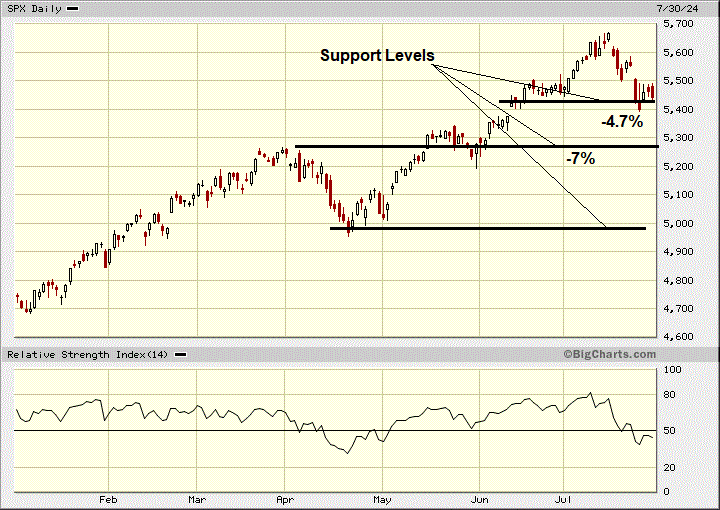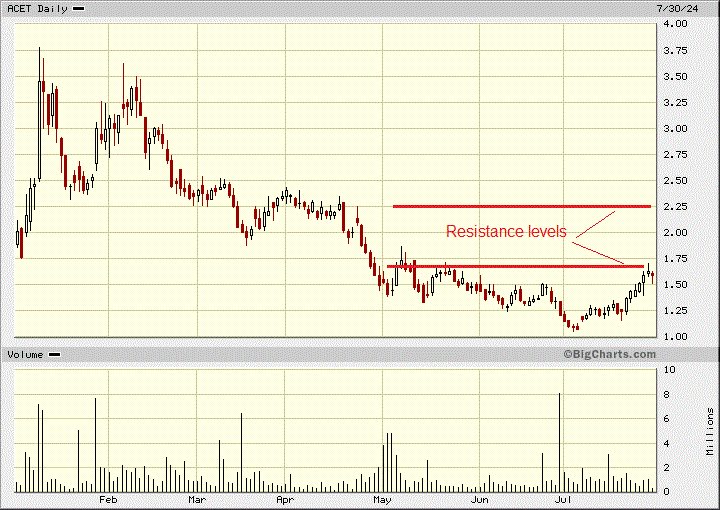The S&P 500 just got rocked, dropping -4.7%% to 5,400, the worst since December 2022. This ends the longest stretch without a 2% drop since the 2007 financial crisis. Though the S&P 500 is still up about 14% YTD. As I commented before, I am just expecting a correction with the market getting hit much harder in the August to October time frame. For now the first support level has held and there is stronger support just below 5,300.
Market rotation continues with most of the correction in the big tech stocks while bio tech and small caps, the Russel 2,000 moving up in July.
The Conference Board said today that its consumer confidence index increased to 100.3 this month from a downwardly revised 97.8 in June. Economists polled by Reuters had forecast the index falling to 99.7 from the previously reported 100.4. From 100.4 to 97.8 is quite a revision but this seems to be the norm with government data these days.
One of our cash rich biotechs has moved up in the July biotech rally.
Adicet Bio - - - - NASDAQ:ACET - - - - - - Recent Price – US$1.55
Entry Price - $1.80 - - - - - - - Opinion - hold
ACET took advantage of the January’s biotech frenzy to cash up its treasury, which curtailed the run in the stock but strengthened the company. This allowed them to expand their phase-1, ADI-001 pipeline beyond Non-Hodgkin’s Lymphoma to now include Lupus Nephritis, which just received FDA fast track designation in June. Last year the FDA partnered with the Lupus Research Alliance to address challenges impacting lupus clinical trial success, so clearly the FDA is eager to find a cure for this disease effecting 1.5m people in the U.S.
In July, Adicet also announced FDA fast track for ADI-270, which is their first ever gamma delta 1 CAR T cell therapy candidate to enter clinical trials for solid tumors.
Interesting is Adicet’s potential ability to “home to tissues”. Many cell therapies work well in the blood which isn’t as effective when needing to direct to specific organs. Adicet’s Gamma Delta 1 T cells have an affinity for tissues, with an ability to target the source of disease. https://www.adicetbio.com/science/. Adicet has plans to tackle several other diseases with their ADI-001 lead candidate. They also stand to receive future royalties from their ADI-002 drug they out-licenced to Regeneron (REGN, $120B) for $45m in 2020.
I think it might soon again become rare to find a biotech stock trading well below its cash value – yet while having major biotech investors in their corner and 2 FDA fast-track approvals.
January financings: ATM program raised $19.3m net proceeds @ $3.13/sh, and the Offering raised $91.6m net proceeds @ $2.40/sh = $110.9m (net of commissions).
Shares Outstanding: Today there are 82.1 shares o/s + 8.4m pre-funded warrants = 90.5m shares (excludes employee options).
Cash at Mar 31, 2024 - $248m which is $3/sh (or $2.74/sh when including the warrants).
Trading price today is $1.55, or 56% of cash value.
Notable shareholders: Orbimed ($17B biotech fund) holds 11.4m sh (13.9%) and sits on the board. RA Capital ($7B fund) holds 7.5m sh (9.2%) plus 8.4m pre-funded warrants. The presence of these two funds helps negates the worry of the company running out of cash, and they’re cashed up until mid-2026.
Short position is 6.42m shares. The company switched its ATM broker to align with the broker who led the January Offering so it’s unlikely they will use the ATM below $2.40/sh any time soon. Therefore short-squeeze rally is possible.
On the chart, the stock hit the first resistance level and bounced lower. I expect it will over come that and should breach the next resistance to get back up to at least cash value near $3.00.
Electronic Arts (EA) US$148.67 - - - 3 year high
Electronic Arts continues to showcase strong potential for growth with its impressive portfolio of popular game franchises such as FIFA, Madden NFL, and The Sims. The gaming industry is experiencing a robust expansion, and EA's focus on live services, digital sales, and esports provides multiple revenue streams. The company's strategic acquisitions, including Codemasters and Glu Mobile, enhance its market presence and diversify its offerings. Additionally, the increasing shift to digital gaming and in-game purchases is bolstering EA's margins. EA's commitment to innovation and new game development, along with its substantial user base, positions it well to capitalize on industry trends. The company's solid financial health, with strong cash flow and a history of share buybacks, further underlines its potential for sustained growth and shareholder value.
The company will report earnings after the close today and the market is expecting good numbers.
Dominion Energy (D) US$52.68 >5% yield
Dominion is a compelling investment in the utility sector, with its focus on clean energy and sustainable practices. The company's strategic transition from traditional fossil fuels to renewable energy sources, such as wind, solar, and natural gas, aligns with global trends toward decarbonization and environmental responsibility. Dominion's robust infrastructure investments and long-term contracts provide stable and predictable revenue streams. The regulated nature of its business ensures a steady cash flow, while the company's dividend yield offers attractive returns for income-focused investors. With its commitment to reducing greenhouse gas emissions and expanding renewable energy capacity, Dominion Energy is well-positioned to benefit from the growing demand for cleaner energy solutions. This strategic vision supports its potential for long-term growth and value creation in a transforming energy landscape.
Dominion is best positioned among utilities for Data Centre growth and it's just over 5% dividend yield means it is a good candidate for my Millennium index. The stock does have resistance around $54.
McDonald's (MCD) US$264 – in a bear trend
McDonald's faces several headwinds that could dampen its growth prospects. Rising health consciousness among consumers is driving a shift away from fast food, impacting sales. Increased competition from healthier, fast-casual dining options presents significant challenges. Additionally, McDonald's global operations expose it to various geopolitical risks, currency fluctuations, and regulatory hurdles. Labor shortages and rising wage pressures are likely to squeeze margins, while supply chain disruptions could lead to higher operational costs. Despite efforts to innovate and diversify the menu, the brand's heavy reliance on traditional fast-food items might hinder its ability to attract new, health-conscious customers. These factors combined could weigh on McDonald's profitability and market share in the highly competitive food industry.
McDonald’s reported quarterly earnings yesterday with revenue below analysts' expectations as same-store sales fell in all divisions. Net income dropped to $2.02 billion ($2.80 per share) from $2.31 billion ($3.15 per share) a year ago. Adjusted earnings were $2.97 per share. Revenue was flat at $6.49 billion compared to last year. Same-store sales decreased by 1%, missing the expected 0.4% growth. U.S. same-store sales fell 0.7%, impacted by reduced consumer spending.
The stock recently tested 2023 lows around $246, a break below that would be very bearish.
IPG Photonics Corporation (IPGP) US$83.27, close to break down
IPG Photonics faces potential challenges that could adversely affect its growth trajectory. The company is heavily reliant on the industrial laser market, which is subject to cyclical demand and economic fluctuations. Slowdowns in key industries such as automotive and manufacturing could impact sales. Additionally, increasing competition from both established players and new entrants in the fiber laser market may pressure pricing and margins. IPG Photonics' significant exposure to international markets introduces risks related to trade policies, tariffs, and geopolitical tensions. The rapid pace of technological advancement necessitates continuous innovation, and any failure to maintain its technological edge could result in market share erosion. These factors combined create an uncertain outlook for IPG Photonics in an evolving and competitive landscape.
IPG announced Q2 results today, much in line with expected lower projections. Second quarter revenue of $258 million decreased 24% year over year. Changes in foreign exchange rates reduced revenue by approximately $6 million or 2%. By region, sales decreased 2% in North America and were down 34% in China, 27% in Europe and 39% in Japan on a year-over-year basis. However, the company projections for Q3 are much weaker still with revenue of $210M ti $240M.
Key support for the stock is $80. A drop below that is bad news and likely coming.
All forecasts and recommendations are based on opinion. Markets change direction with consensus beliefs, which may change at any time and without notice. The author/publisher of this publication has taken every precaution to provide the most accurate information possible. The information & data were obtained from sources believed to be reliable, but because the information & data source are beyond the author's control, no representation or guarantee is made that it is complete or accurate. The reader accepts information on the condition that errors or omissions shall not be made the basis for any claim, demand or cause for action. Because of the ever-changing nature of information & statistics the author/publisher strongly encourages the reader to communicate directly with the company and/or with their personal investment adviser to obtain up to date information. Past results are not necessarily indicative of future results. Any statements non-factual in nature constitute only current opinions, which are subject to change. The author/publisher may or may not have a position in the securities and/or options relating thereto, & may make purchases and/or sales of these securities relating thereto from time to time in the open market or otherwise. Neither the information, nor opinions expressed, shall be construed as a solicitation to buy or sell any stock, futures or options contract mentioned herein. The author/publisher of this letter is not a qualified financial adviser & is not acting as such in this publication.





